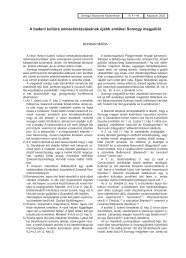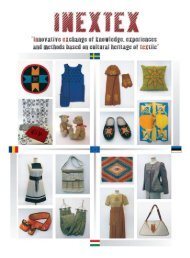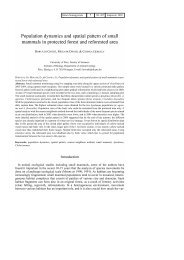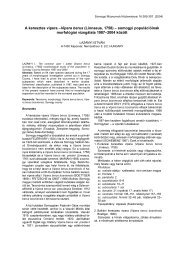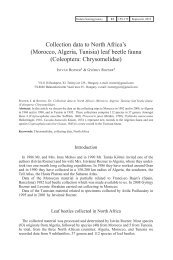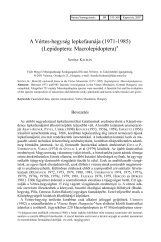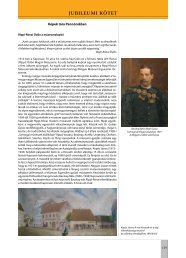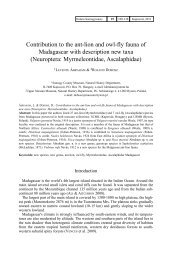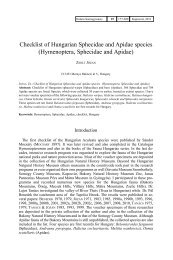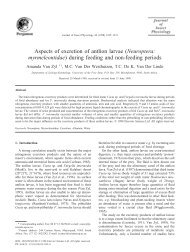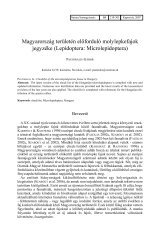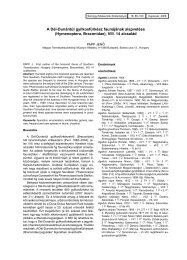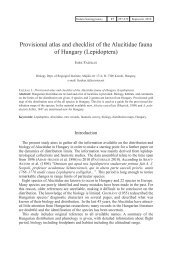Study on the Palaearctic Pristiphora species (Hymenoptera ...
Study on the Palaearctic Pristiphora species (Hymenoptera ...
Study on the Palaearctic Pristiphora species (Hymenoptera ...
You also want an ePaper? Increase the reach of your titles
YUMPU automatically turns print PDFs into web optimized ePapers that Google loves.
HARIS A.: STUDY ON THE PALAEARCTIC PRISTIPHORA SPECIES<br />
211<br />
variable light colour. Figs. 197, 202, 209 and 218.................................................table K<br />
- More extensively light coloured <strong>species</strong>. Abdominal sternites light or <strong>the</strong> total body<br />
sometimes even <strong>the</strong> head light coloured. Figs. 192 and 196...................................table L<br />
Males<br />
1. Head and <strong>the</strong> whole thorax densely punctured matt. Larger <strong>species</strong>: (5.0) 6.0-7.0<br />
mm. Apex of penis valve acute, with ventral bypass (Figs. 57-64) except P. mollis<br />
(Hartig) (Fig. 56). Body dominantly black. Pr<strong>on</strong>otum, tegula and legs partly straw yellow<br />
or ochraceous.................................................................................................Table M<br />
- At least partly <strong>the</strong> thorax (mesopleur<strong>on</strong> or mes<strong>on</strong>otum) more or less shining. If <strong>the</strong><br />
<strong>species</strong> is matt than smaller and/or penis valve structure and colorati<strong>on</strong> different.........2.<br />
2. Mesosternum always pale. Body variously coloured from dark till wholly pale.<br />
Penis valves in Figs. 132 and 151-161...................................................................Table N<br />
- Mesosternum dark (mostly black)..............................................................................3.<br />
3. At least abdominal sternites in <strong>the</strong> middle yellow or abdomen red banded............Table O<br />
- Abdominal tergites and sternites always dark (Sometimes apical sternite(s) of<br />
abdomen may be light coloured)......................................................................................4.<br />
4. Penis valve curved in <strong>the</strong> middle, its lobe chitinised and golden coloured with small<br />
spines al<strong>on</strong>g its margin (Figs.64-72) or penis valve with fine cilia <strong>on</strong> dorsal margin (Figs.<br />
72-80).................................................................................................................... Table P<br />
- Penis valve different..................................................................................................5.<br />
5. Penis valve with hook (Figs. 107-130). Dominantly black <strong>species</strong>, tegula may be<br />
pale. Legs black and white, sometimes entirely dark (black and dark brown) or entirely<br />
white......................................................................................................................Table Q<br />
- Penis valve without hook. Variously coloured <strong>species</strong>..............................................6.<br />
6. Penis valve acute (Figs. 162 and 163). Thorax, head and legs more or less coloured<br />
with yellow. Small <strong>species</strong> 3.0-4.5 mm.(Subgenus Sharliphora W<strong>on</strong>g, 1969)......Table R<br />
- Penis valve different. Head, thorax and abdominal tergites and sternites dominantly<br />
black. Pr<strong>on</strong>otum, tegula may be light coloured.......................................................Table S<br />
FEMALES<br />
Table A<br />
Subgenus <strong>Pristiphora</strong> Latreille, 1810. Sawsheath extremely deeply notched, has a pair<br />
of pliers shape, see Fig. 1.<br />
1. Abdomen yellow with l<strong>on</strong>gitudinal black stripe. Head ochraceous (in male with<br />
large black spot <strong>on</strong> fr<strong>on</strong>tal area). Sawsheath in Fig. 1. Thorax black with ochraceous<br />
spots. Hind legs black. (Fig. 186) 6.0-8.0 mm........................................P. fausta (Hartig)<br />
Hungary, Austria, Belgium, Slovakia, Switzerland, Germany, France, Ne<strong>the</strong>rlands, Portugal, Turkey and<br />
Asia Minor.<br />
- Abdominal tergites black, sternites and sawsheath yellow. Head black but labrum,<br />
mandibles and clypeal margin yellow. Thorax black <strong>on</strong>ly pr<strong>on</strong>otum and tegula yellow. Legs<br />
nearly entirely yellow, <strong>on</strong>ly <strong>the</strong> very base of hind coxa black and apex of hind tibia with light<br />
brown ring. Fig. 194. Small <strong>species</strong>: 4.1 mm. Males unknown.........P. m<strong>on</strong>golofausta Haris<br />
Known <strong>on</strong>ly from M<strong>on</strong>golia.



